osgEarth Documentation
Release 2.4
Pelican Mapping
May 22, 2013
�
�
1 Table of Contents
.
.
.
1.1 About the Project .
Building osgEarth .
1.2
.
1.3 User Guide .
.
1.4 Developer Topics .
.
1.5 Working with Data .
1.6
.
.
1.7
1.8
.
Reference Guides .
.
FAQ .
.
Release Notes
.
.
.
.
.
.
.
CONTENTS
.
.
.
.
.
.
.
.
.
.
.
.
.
.
.
.
.
.
.
.
.
.
.
.
.
.
.
.
.
.
.
.
.
.
.
.
.
.
.
.
.
.
.
.
.
.
.
.
.
. . . . . . . . . . . . . . . . . . . . . . . . . . . . . . . . . . . .
. . . . . . . . . . . . . . . . . . . . . . . . . . . . . . . . . . . . .
. . . . . . . . . . . . . . . . . . . . . . . . . . . . . . . . . . . . .
.
. . . . . . . . . . . . . . . . . . . . . . . . . . . . . . . . . . . .
. . . . . . . . . . . . . . . . . . . . . . . . . . . . . . . . . . . . .
.
. . . . . . . . . . . . . . . . . . . . . . . . . . . . . . . . . . . .
. . . . . . . . . . . . . . . . . . . . . . . . . . . . . . . . . . . . .
.
. . . . . . . . . . . . . . . . . . . . . . . . . . . . . . . . . . . .
3
3
5
6
23
32
34
61
64
i
�
ii
�
osgEarth Documentation, Release 2.4
Welcome to the osgEarth documentation project!
osgEarth is a big SDK. Keeping up on the documentation is not easy! So now we’ve moved the docs right into the
osgEarth Git repository to make it easier for the osgEarth team and user community to help. Check the links at the
bottom of the sidebar.
CONTENTS
1
�
osgEarth Documentation, Release 2.4
2
CONTENTS
�
CHAPTER
ONE
TABLE OF CONTENTS
1.1 About the Project
1.1.1 Introduction
osgEarth is a 3D mapping SDK for OpenSceneGraph applications. It’s different than traditional terrain engines in an
important way: osgEarth does not require you to build a 3D terrain model before you display it. Instead, it will access
the raw data sources at application run time and composite them into a 3D map on the fly. No terrain model is actually
stored to disk, though it does use caching techniques to speed up the rendering of the map.
The goals of osgEarth are to:
• Enable the development of 3D geospatial appliations on top of OpenSceneGraph.
• Make it as easy as possible to visualize terrian models and 3D maps.
• Interoperate with open mapping standards, technologies, and data.
So if it for me?
So: does osgEarth replace the need for offline terrain database creation tools? In many cases it does.
Consider using osgEarth if you need to:
• Get a terrain base map up and running quickly and easily
• Access open-standards map data services like WMS, WCS, or TMS
• Integrate locally-stored data with web-service-based data
• Incorporate new geospatial data layers at run-time
• Run in a “thin-client” environment
• Deal with data that may change over time
• Integrate with a commercial data provider
1.1.2 Community Resources
Since osgEarth is a free open source SDK, the source code is available to anyone and we welcome and encourage
community participation when it comes to testing, adding features, and fixing bugs.
Support Forum
The best way to interact with the osgEarth team and the user community is through the support forum.
Please read and follow these guidelines for using the forum:
3
�
osgEarth Documentation, Release 2.4
• Sign up for an account and use your real name. You can participate anonymously, but using your real
name helps build a stronger community (and makes it more likely that we will get to your question
sooner).
• Limit yourself to one topic per post. Asking multiple questions in one post makes it too hard to keep
track of responses.
• Always include as much supporting information as possible. Post an earth file or short code snippet.
Post the output to osgearth_version --caps. Post the output to gdalinfo if you are
having trouble with a GeoTIFF or other data file. List everything you have tried so far.
• Be patient!
OSG Forum
Since osgEarth is built on top of OpenSceneGraph, many questions we get on the message boards are
really OSG questions. We will still try our best to help. But it’s worth your while to join the OSG Mailing
List or read the OSG Forum regularly as well.
Social Media
• Follow @pelicanmapping on twitter for updates.
• Add our Google+ Page to your circles for gallery shots.
Professional Services
The osgEarth team supports its efforts through professional services. At Pelican Mapping we do custom
software development and integration work involving osgEarth (and geospatial technologies in general).
We are based in the US but we work with clients all over the world. Contact us if you need help!
1.1.3 License
Pelican Mapping licenses osgEarth under the LGPL free open source license.
This means that:
1. You can link to the osgEarth SDK in any commercial or non-commercial application free of charge.
2. If you make any changes to osgEarth itself, you must make those changes available as free open source software
under the LGPL license. (Typically this means contributing your changes back to the project, but it is sufficient
to host them in a public GitHub clone.)
3. If you redistribute the osgEarth source code in any form, you must include the associated copyright notices and
license information unaltered and intact.
4. iOS / static linking exception: The LGPL requires that anything statically linked to an LGPL library (like
osgEarth) also be released under the LGPL. We grant an exception to the LGPL in this case. If you statically
link osgEarth with your proprietary code, you are NOT required to release your own code under the LGPL.
That’s it.
1.1.4 Maintainers
Pelican Mapping maintains osgEarth. We are located in the Washington, DC area.
Pelican is Glenn, Jason, Jeff, and Paul.
4
Chapter 1. Table of Contents
�
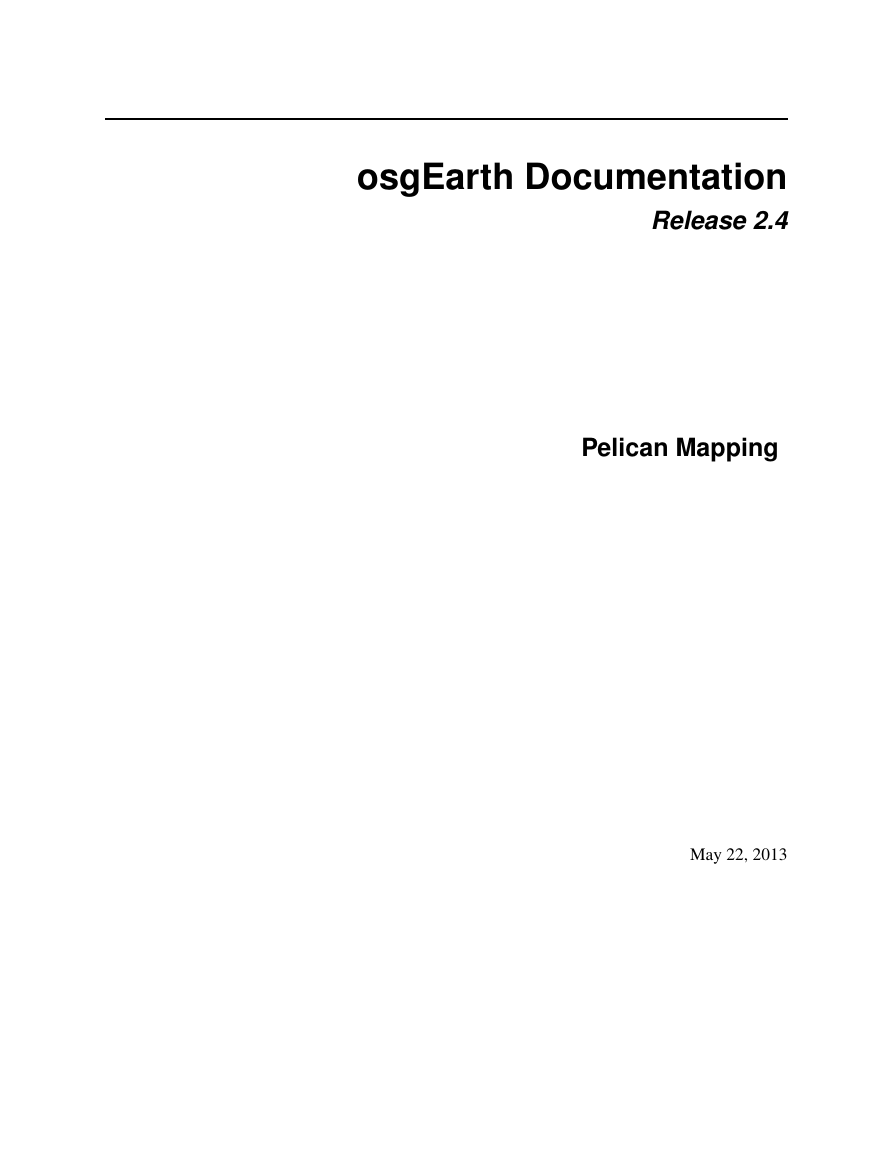

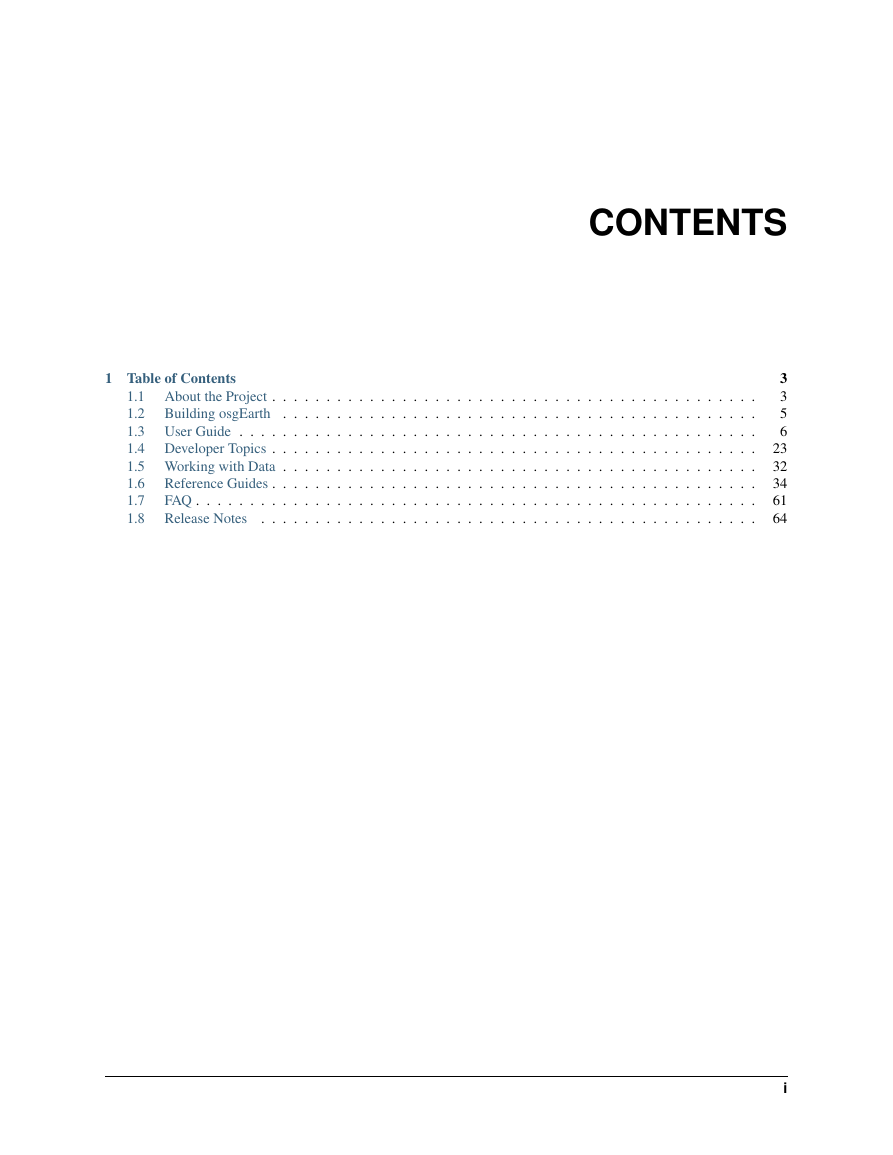

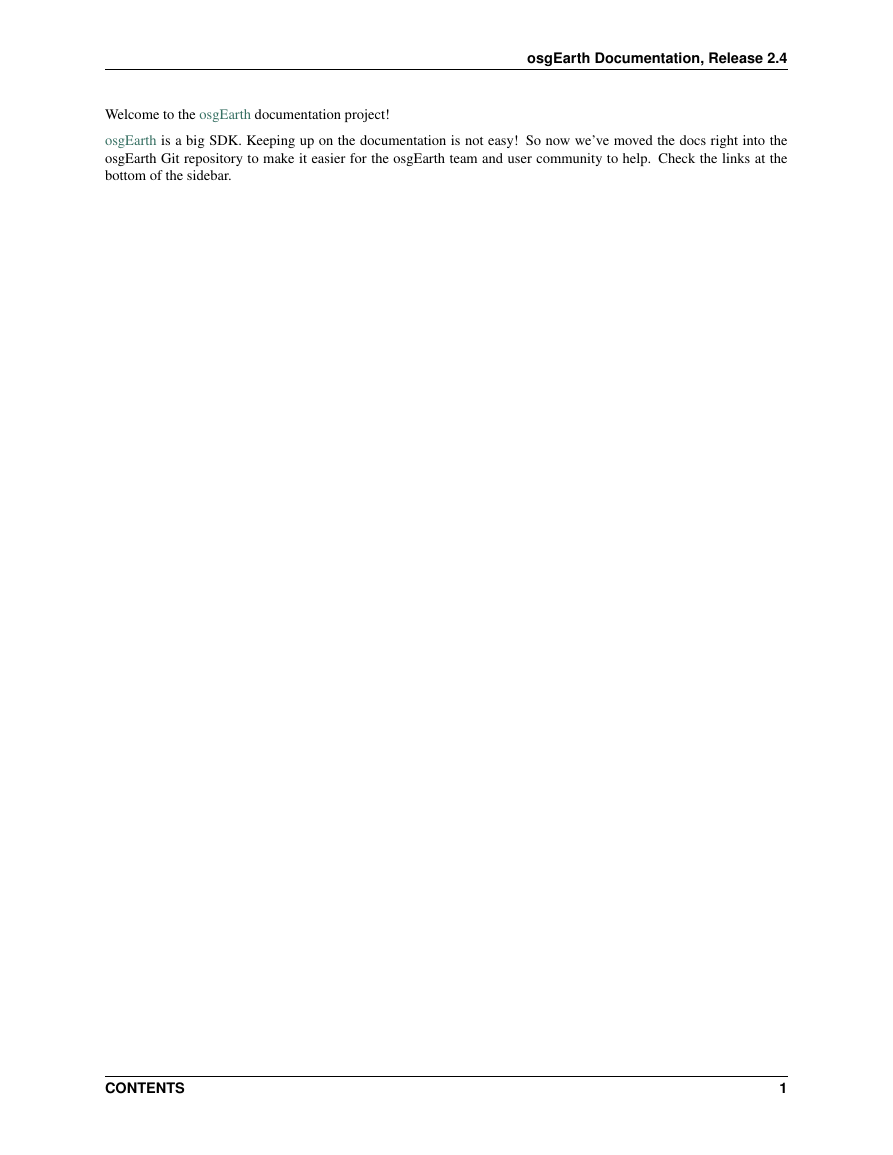

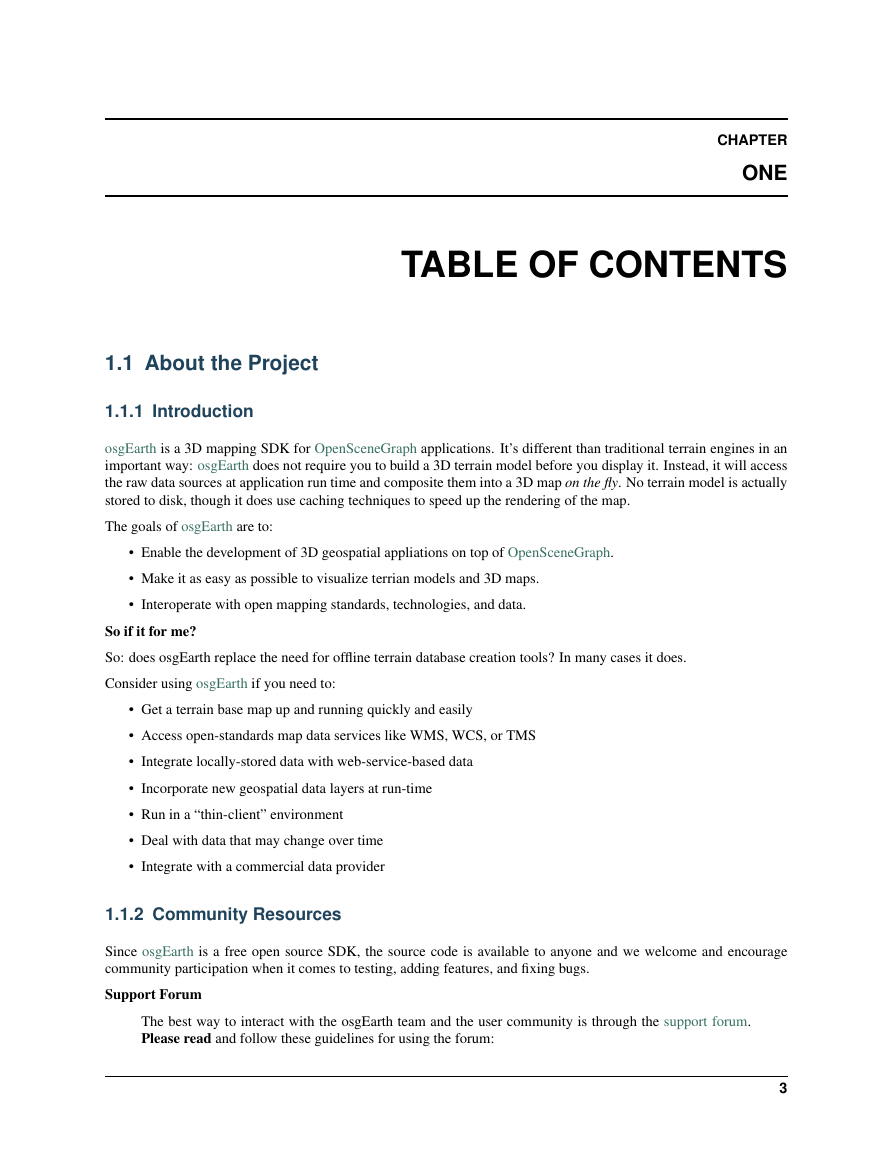
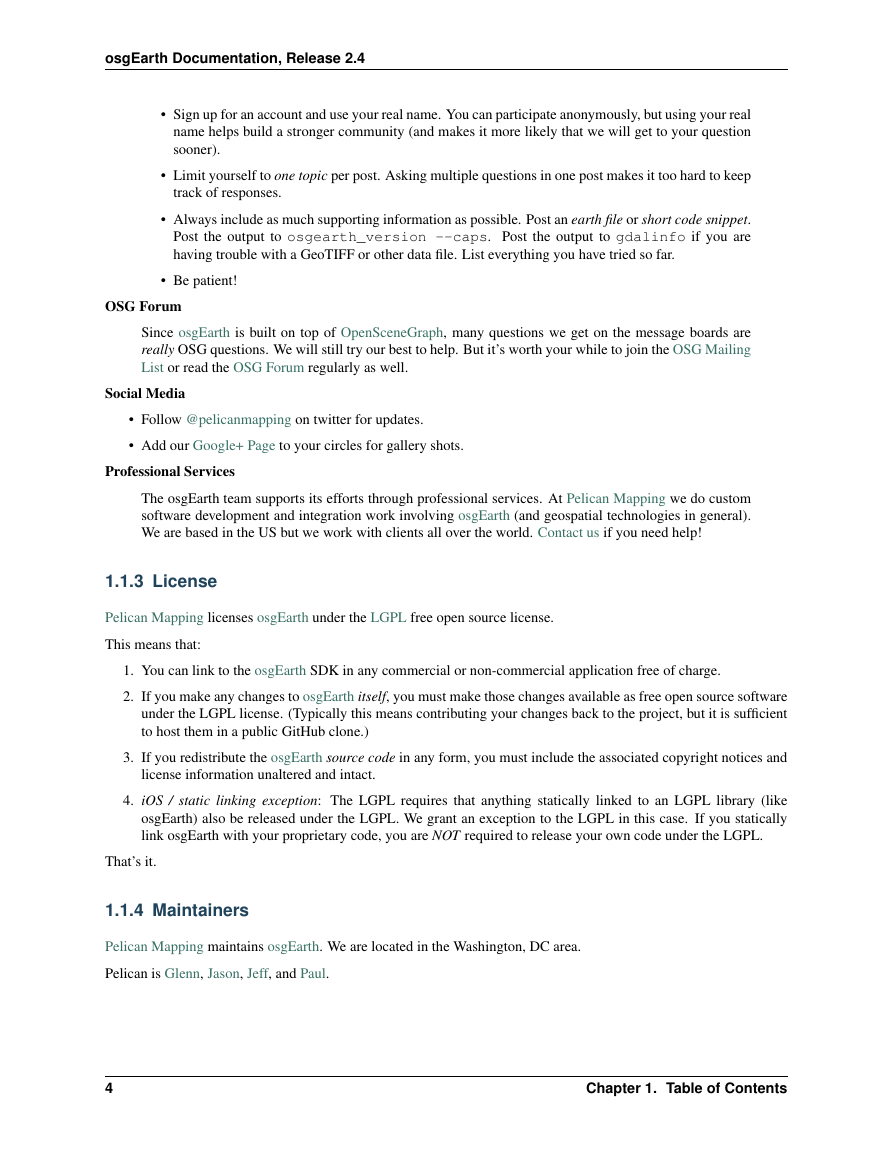








 2023年江西萍乡中考道德与法治真题及答案.doc
2023年江西萍乡中考道德与法治真题及答案.doc 2012年重庆南川中考生物真题及答案.doc
2012年重庆南川中考生物真题及答案.doc 2013年江西师范大学地理学综合及文艺理论基础考研真题.doc
2013年江西师范大学地理学综合及文艺理论基础考研真题.doc 2020年四川甘孜小升初语文真题及答案I卷.doc
2020年四川甘孜小升初语文真题及答案I卷.doc 2020年注册岩土工程师专业基础考试真题及答案.doc
2020年注册岩土工程师专业基础考试真题及答案.doc 2023-2024学年福建省厦门市九年级上学期数学月考试题及答案.doc
2023-2024学年福建省厦门市九年级上学期数学月考试题及答案.doc 2021-2022学年辽宁省沈阳市大东区九年级上学期语文期末试题及答案.doc
2021-2022学年辽宁省沈阳市大东区九年级上学期语文期末试题及答案.doc 2022-2023学年北京东城区初三第一学期物理期末试卷及答案.doc
2022-2023学年北京东城区初三第一学期物理期末试卷及答案.doc 2018上半年江西教师资格初中地理学科知识与教学能力真题及答案.doc
2018上半年江西教师资格初中地理学科知识与教学能力真题及答案.doc 2012年河北国家公务员申论考试真题及答案-省级.doc
2012年河北国家公务员申论考试真题及答案-省级.doc 2020-2021学年江苏省扬州市江都区邵樊片九年级上学期数学第一次质量检测试题及答案.doc
2020-2021学年江苏省扬州市江都区邵樊片九年级上学期数学第一次质量检测试题及答案.doc 2022下半年黑龙江教师资格证中学综合素质真题及答案.doc
2022下半年黑龙江教师资格证中学综合素质真题及答案.doc